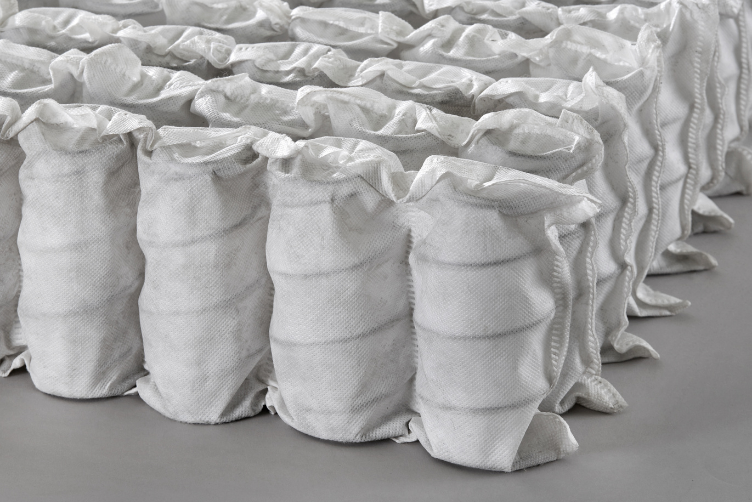The whole ‘open coil mattress vs pocket sprung options’ is a common cause for debate when on the lookout for a new mattress. In our blog, we outline the differences between the two, helping you to settle on the best option for you.
Generally, there are four types of mattresses: pocket sprung, open coil, memory foam and latex. These four types can be narrowed down even further into categories of mattresses with spring systems (pocket sprung and open coil) or foam-like structures (memory and latex). Whilst open coil and pocket sprung mattresses go under this umbrella together, they’re still significantly different.
Pinpointing the exact differences can be difficult to the untrained eye. So, to help you figure out which one is best for you, we’re going to talk you through the main differences between open coil and pocket sprung mattresses.
With both types of mattresses offering their own pros and cons, here’s how open coil and pocket sprung mattresses differ:
One of the main differences between these two mattresses is their respective spring structures. Not to be confused with continuous coil mattresses where the springs are of the same length of wire, open coil mattresses have individual springs that are all connected by a continuous wire.
 Pocket springs
Pocket springs
As for a pocket sprung mattress, they have individual springs that are sewn into their own fabric pockets. The main difference in the functionality of these types is that pocket springs can move independently from one another, giving them the superior ability to mould to the contours of your body.
Because pocket sprung mattresses are more able to move with the shape of your body, making them generally more supportive. Pocket springs can help promote correct spine alignment and relieve pressures from strained parts of the body. However, this is not to say that an open coil mattress can’t be supportive, as Silentnight’s Miracoil (pictured) and Sealy’s Posturepedic mattresses demonstrate through the use of high-quality materials in the filling, cover and spring system.
These innovative systems in open coil mattresses can bypass what a pocket sprung mattress does for you – it really depends on what you’re looking for. Miracoil and Posturepedic mattresses are great for people who are looking for firmer support and backcare. If you aren’t looking for either of those things, then you may be more swayed towards a pocket sprung mattress that potentially offers more comfort.
 Comfort: pocket sprung vs open coil mattresses
Comfort: pocket sprung vs open coil mattresses
When it comes to comfort, this is quite difficult to determine as every mattress is subject to everyone’s preferences. With both kinds of mattress, you can find tensions varying from softer to extra firm, with an array of fillings as well as differing mattress depths. Depending on what you find comfortable will determine what aspects you like in a mattress.
However, when speaking generally, a pocket sprung mattress allows you to move independently from a partner, thus having undisturbed slumbers. You cannot get this in an open coil mattress because the continuous wire that connects every spring will cause other springs to shift in unison.
On top of this, the springs in an open coil mattress lose their form quicker, which can lead to ‘roll-together’ in the middle of the mattress. The longevity of a pocket spring is better which may contribute to increased comfort overall.
Ultimately, mattress comfort is dictated by how well it conforms to your body’s pressure points. If your spine, neck and shoulders are supported adequately, it’s likely that you’ve found a mattress that’s just right. If you need help determining the right type of mattress for you, have a read through our mattress buying guide for some more advice on sizes, builds, finishes, fillings and care.
Yes, pocket springs react independently in accordance with body movements therefore ensuring that any movements elsewhere in the bed will have minimal influence on your night’s sleep.
Generally, the price of an open coil mattress is a lot cheaper in comparison to a pocket sprung mattress. You may be sacrificing some aspects of comfort with an open coil, whilst it’s also much cheaper and easier to manufacture in comparison to a pocket sprung.
With there being a minimum of 800 springs that have to be sewn into pockets for a pocket sprung mattress, it makes the manufacturing process longer and more expensive. However, not all pocket sprung mattresses are ragingly expensive. You can find mattresses on both ends of the price spectrum in both types of mattresses. With Mattressman, there are generally more open coil mattresses below £200 than there are for pocket sprung, making open coil the better option if you’re balancing comfort and budget.
Mattress materials are always a tricky subject. There are environmental concerns, comfort issues and supply problems but generally, natural materials like cotton and wool are preferred. Sometimes, these are substituted for synthetic materials such as latex, polyurethane or even vinyl.
In the case of pocket sprung and open coil mattresses, material usage differs product by product. While there are a range of pocket sprung mattresses with natural materials, the same can be said for open coil mattresses. The main difference here being the materials of the springs themselves. On average, pocket sprung mattresses contain around 1,000 springs, whereas open coil mattresses tend to have 300-500. Despite the number of springs being much lower, the material usage between these types of mattresses is comparable.
With all that’s been said, there are clear pros and cons to both types of mattresses. If you have a higher budget, a pocket sprung mattress offers more comfortable aspects than an open coil mattress. However, if you’re on a lower budget, it’s certainly not impossible to find a pocket sprung mattress for you. Open coil mattresses are great as a budget option or for those who have backcare at the forefront of their mind. Overall, it truly depends on what you find to suit you best.
Have you got an open coil or pocket sprung mattress? Have you shifted from one type to another? Let us know what you think about either.